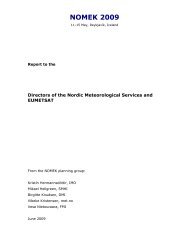International Symposium on Mitigative Measures against Snow ...
International Symposium on Mitigative Measures against Snow ...
International Symposium on Mitigative Measures against Snow ...
Create successful ePaper yourself
Turn your PDF publications into a flip-book with our unique Google optimized e-Paper software.
<str<strong>on</strong>g>Internati<strong>on</strong>al</str<strong>on</strong>g> <str<strong>on</strong>g>Symposium</str<strong>on</strong>g> <strong>on</strong> <strong>Mitigative</strong> <strong>Measures</strong> <strong>against</strong> <strong>Snow</strong> Avalanches<br />
Egilsstaðir, Iceland, March 11–14, 2008<br />
An avalanche index for roads<br />
Árni Jónss<strong>on</strong> 1 * and Krister Kristensen 2<br />
1 ORION C<strong>on</strong>sulting, Foldarsmári 6, IS-201 Kópavogur, ICELAND<br />
2 Norwegian Geotechnical Institute, PO Box 3930 Ullevål Stadi<strong>on</strong>, N-0806 Oslo, NORWAY<br />
*Corresp<strong>on</strong>ding author, e-mail: arni (at) ori<strong>on</strong>.is<br />
ABSTRACT<br />
Several methods have been introduced through the years to evaluate avalanche risk al<strong>on</strong>g road<br />
secti<strong>on</strong>s. In 1988, Peter Schaerer introduced Avalanche Hazard Index, a numerical expressi<strong>on</strong><br />
of damage and loss as the result of an interacti<strong>on</strong> between snow avalanches and vehicles <strong>on</strong> a<br />
road. Later works by different authors have developed the methodology for risk management<br />
and winter road opening of high alpine pass roads.<br />
This project is a spin-off of a project c<strong>on</strong>ducted by ORION C<strong>on</strong>sulting for the Icelandic Road<br />
Authority. This project describes a simple method to evaluate possible c<strong>on</strong>sequences of an<br />
avalanche hitting a passing vehicle <strong>on</strong> a road secti<strong>on</strong>. Besides the size, intensity and frequency<br />
of avalanches, the severity of the c<strong>on</strong>sequences is related to several envir<strong>on</strong>mental factors<br />
such as the distance from the road body to potentially dangerous terrain features. Such<br />
factors may include cliffs and steep banks al<strong>on</strong>g fjords, as well as steep slopes above the road.<br />
In additi<strong>on</strong>, the c<strong>on</strong>sequences of an encounter between a vehicle and an avalanche may depend<br />
<strong>on</strong> the probability of a speedy rescue.<br />
The factors used are quantified <strong>on</strong> a scale from 0−5, where the lower values are given the<br />
worse case and higher values the more favourable.<br />
Test results show that this procedure gives other results than a preliminary assessment suggests<br />
in some cases. At a specific avalanche threatened stretch of road site in northern Iceland,<br />
a different avalanche path received a higher index value than the <strong>on</strong>e that initially was c<strong>on</strong>sidered<br />
the worst.<br />
1. INTRODUCTION<br />
At present, neither guidelines nor other instructi<strong>on</strong>s are available for the road authority in<br />
Iceland to evaluate the avalanche threat to the road traffic or to prioritize necessary measures.<br />
In 2000, the Ministry of Envir<strong>on</strong>ment published regulati<strong>on</strong>s for populated areas. The safety<br />
requirements are related to individual risk, defined as the probability of a fatal injury of an<br />
individual living (with occupancy of 75% of the time) in an un-reinforced house. The actual<br />
risk can be estimated by c<strong>on</strong>sidering the probability of an individual staying at home, the<br />
avalanche frequency and intensity, and the strength of the building.<br />
Risk-based methods based <strong>on</strong> encounter probability and average values for mortality have<br />
been used before, i.e. in the Avalanche Index Method (Schaerer, 1989). However it is possible<br />
to extend these methods by introducing several envir<strong>on</strong>mental factors that can affect the<br />
survival of avalanche victims. For instance, a small avalanche that hits a car in an unfavourable<br />
or a remote area can have disastrous c<strong>on</strong>sequences for those in the car. On the other<br />
hand, if c<strong>on</strong>diti<strong>on</strong>s were more favourable the travellers might do well. Thus, the encounter<br />
probability al<strong>on</strong>e does not always show the whole risk picture.<br />
208 Avalanche index for roads











